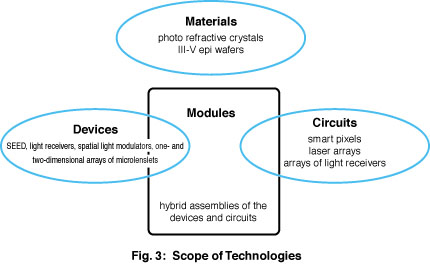
The US-Japan Joint Optoelectronics Project or JOP was devised as part of the RWC Project and focused on prototype development of an innovative system for computing technology based on optoelectronic devices.
Reflecting on the current immature state of the research and development environment for optoelectronic technologies, the JOP was established to help promote optoelectronics relevant to computing technology on a cooperative basis between the United States and Japan. To help develop advanced optoelectronic devices which are essential for the development of real-world computing technologies, a trilateral system involving brokers, users and suppliers was drawn up, in which the broker intermediately communicates the user's design and specification requests of a prototype to the supplier. The supplier then actually manufactures and delivers the prototype to the user.
To put the policy into practice, some specific targets have been established as follows.
(1) To improve the availability of novel prototype optoelectronic devices, circuits, and modules by providing the Users with access to leading edge optoelectronic fabrication facilities.
(2) To stimulate R&D activity in optoelectronics for computing in both the United States and Japan and to encourage effective commercialization.
(3) To implement the Plan of Action associated with the Global Partnership agreement between the United States and Japan that the both countries engage in feasibility studies on cooperation in optoelectronic technologies.
(4) To develop a model for U.S.-Japan cooperative research.

This project is jointly controlled by the US and Japanese governments based on the Implementation Plan of the US-Japan Joint Optoelectronics Project agreed upon by the two countries on April 25, 1994.
The US and Japanese brokers work as intermediaries between users and suppliers under the provisions of the JOP Implementation Plan. The Optoelectronics Industry and Technology Development Association (OITDA) serves as the Japanese broker and the Optoelectronics Industry Development Association (OIDA) is the US counterpart.
Figures 1 to 3 show the management system, the procedure and the coverage of technology fields of the JOP. Table 1 indicates the current status of its activities.



As a result of its three-year trial project assessment done by the US-Japan Joint Management Committee, the JOP was found to be an effective initiative and so it was decided to continue the project until 2001, the end of the RWC Project. The US-Japan Joint Management Committee with 10 members, five from the US and Japan respectively, is responsible for managing the project and establishing the project implementation plan.
The Japanese members of the Joint Management Committee are representatives from the Machinery and Information Industries Bureau of MITI, Agency of Industrial Science and Technology, Electrotechnical Laboratory and RWCP. And the US members are from NIST of the Department of Commerce, Department of Defense, Department of Energy, Department of State and NSF (National Science Foundation).